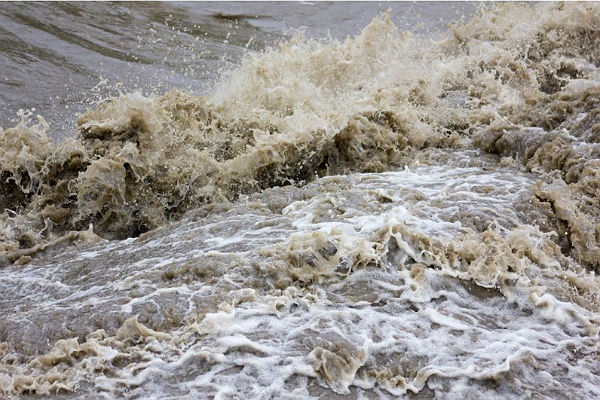 For communities from Harlem to Hollis Mayor Bill de Blasio, New York City Economic Development Corporation (NYCEDC), and Mayor’s Office of Climate Resiliency (MOCR) are taking action.
For communities from Harlem to Hollis Mayor Bill de Blasio, New York City Economic Development Corporation (NYCEDC), and Mayor’s Office of Climate Resiliency (MOCR) are taking action.
They are taking action against the serious effects of climate change.
Announcing today that the City will allocate $110 million to a new capital project to help address sea-level rise and storm surge that together pose a serious threat to Lower Manhattan.
“As we approach the nine-year anniversary of Superstorm Sandy we must ensure that families, businesses, and communities in Lower Manhattan, one of the most densely populated parts of our city, are protected from the accelerating effects of climate change,” said Mayor Bill de Blasio. “This project does just that, guaranteeing that some of the most vulnerable areas can continue to thrive for generations to come.”
“Changing weather patterns and sea levels have made protecting the South Street Seaport a near-term and non-negotiable necessity,” said Deputy Mayor of Housing and Economic Development Vicki Been. “Together with the Mayor’s Office, EDC & MOEC, we are responding with significant investments in the future of Lower Manhattan.”
“Climate Change is causing stronger and more devastating storms, and we must take action to protect our coastline and lessen the severe impact,” said NYCEDC President & CEO Rachel Loeb. “This project to safeguard one of the most low-lying, vulnerable areas, the Seaport District, is the first step in better protecting residents, business owners, and infrastructure from flooding. NYCEDC is focused on this work with MOCR, and we thank the Mayor for his support of this critical project and our efforts to unlock federal funding to support our long-term coastal resiliency efforts.”
“This critical project will protect the lowest-lying neighborhood in Lower Manhattan, the Seaport District, from tidal flooding caused by rising sea levels,” said Jainey Bavishi, Director of the Mayor’s Office of Climate Resiliency. “It is a crucial first step in implementing the soon-to-be-released Financial District and Seaport Climate Resilience Master Plan. Lower Manhattan is a critical economic hub for New York City, providing 10% of the city’s total jobs. Without investments like this, the impacts of climate change in Lower Manhattan will be felt far beyond New York City.”
According to the New York City Panel on Climate Change, without action, the Seaport waterfront could be flooded monthly within the next 25 years due to sea-level rise. Sea level is expected to rise approximately 2.5 feet by the 2050s, resulting in regular and repeated inundations during high tides. In response, the City plans to use the $110 million to begin coastal resiliency work in the historic Seaport District, which is especially vulnerable due to its low elevation. The proposed project, which will be subject to appropriate review, will rebuild and raise the existing bulkhead and improve drainage in the area from approximately the Brooklyn Bridge to Pier 17. These efforts will protect about 15 acres of historic Lower Manhattan and will prevent up to $400 million dollars in damages and the long-term erosion of the district anticipated as a result of chronic flooding. Additionally, the project will continue to help improve access to the waterfront for New Yorkers and will help position the City to apply for federal funding needed to safeguard all of Lower Manhattan.
“I applaud the City’s new $110 million capital commitment to the Seaport District and increasing resiliency in Lower Manhattan,”’ said Congressman Jerry Nadler. “This kind of investment in infrastructure and flood protection is a necessary first step in addressing the urgency of the climate crisis in a community that was badly hit by Superstorm Sandy. I am proud to have helped bring federal resources to the City to assist in the recovery and will continue to work with our federal, city, and state partners to do so in the next phases of our resiliency efforts to protect our vulnerable neighborhoods from the threats of sea-level rise, future storms and other destructive effects of climate change.”
“This investment by the Administration is a good start, but Hurricane Ida reminded us that we must act boldly and quickly to protect our city from the effects of climate change,” said Manhattan Borough President Gale A. Brewer. “Lower Manhattan is home to hundreds of thousands of New Yorkers and is a critical economic engine, and the Seaport District is a historic and cultural treasure. We need action from all levels of government to keep our city safe from storm surge and sea-level rise. I look forward to working with my colleagues in government and members of the community to plan for our collective climate future.”
“As this summer has reminded us once again, in tragic fashion, the catastrophic effects of climate change are already with us today,” said Senator Brian Kavanagh. “Events like Hurricane Ida and Superstorm Sandy will only continue to occur with greater frequency, and even as we push for huge investments in preventing climate-changing pollution, it is also imperative that we invest now in mitigating the effects of extreme weather, coastal storm surge, and other dangers. Lower Manhattan–one of the nation’s largest economic and cultural hubs and home to thousands of people–is especially at risk, and investing in coastal resiliency here will safeguard jobs and critical infrastructure that serve the entire City. While we have a long way to go before there is a consensus regarding plans to protect the historic Seaport District, one of our most vulnerable areas, the commitment of $110 million in capital funding is an important first step toward creating the protection we need. I look forward to continuing to work with my colleagues in government–including the de Blasio administration and the new administration in January–and our community partners, toward a comprehensive approach that will safeguard our communities from the dangers of climate change.”
“Manhattan Community Board 1 is pleased by the City’s commitment of $110 million in new funding for resiliency infrastructure in the Seaport Historic District,” said Chair of Manhattan CB1 Tammy Meltzer. “This is the result of years of collaborative planning towards how to protect the Financial District/Seaport areas from future climate change and extreme weather events, and we are encouraged by this definitive step in securing the future of the Lower Manhattan Coastal Resiliency project.”
This critical project in the Seaport District is a standalone component of a broader strategy to be described in NYCEDC’s and MOCR’s forthcoming Financial District and Seaport Climate Resilience Master Plan, which will identify feasible solutions to safeguard one mile of unprotected coastline in one of the most complex areas of the city. The full plan is expected to be released by the end of the year. The master plan is part of the larger Lower Manhattan Coastal Resiliency (LMCR) initiative, backed by $800 million in City investments to protect Lower Manhattan and New Yorkers from the threats of climate change.
Protecting Lower Manhattan is imperative to the city’s overall coastal resiliency strategy because it’s home to one of the nation’s largest business districts, and flooding will put transit, serving millions, along with critical infrastructure and jobs at risk. With 75% of our subway lines and the most popular ferry lines in the country, millions of people from across the five boroughs and tri-state travel through Lower Manhattan every day. The area holds a diversity of jobs, including small business owners, construction workers, building services providers, and those who work in healthcare, technology, and financial industries. A protected Lower Manhattan coastline protects jobs and critical infrastructure serving all New Yorkers.
“Enhancing climate resilience means taking immediate actions to reduce potential future losses by planning and preparing for climate hazards such as extreme rainfall, sea-level rise, stormwater flooding, and urban heat. The historic Seaport district and the surrounding residences, schools, and businesses are at the frontline of these hazards,” said Cortney Koenig Worrall, President, and CEO, Waterfront Alliance. “Today’s investment sends a signal that there is no time to waste. Moreover, with the possibility that billions in federal resiliency dollars will come to our region, we commend the Mayor’s Office for making this significant infrastructure investment. We hope to see more expedient capital investments like this one across all at-risk communities.”
“Lower Manhattan drives the economy of our city, state, and country. Its transportation hubs and jobs power the region, and it must be protected. This is a critical, significant step and we hope it is only the beginning of an effort that continues throughout the next Mayoral administration,” said Jessica Lappin, President, Alliance for Downtown New York. “Fortifying our most vulnerable waterfronts is essential to our city’s future.”
“As we approach the 9-year anniversary of SuperStorm Sandy and are reminded of the devastation it brought to Lower Manhattan, especially along the East River, this financial commitment by NYC is a great first step to protect several vulnerable blocks of the 0.90-mile FiDi-Seaport shoreline. This vital work of rebuilding and raising the bulkheads, and improving drainage, along with much-needed esplanade improvements, should be considered a down payment as we look forward to additional investment and commitment from the next administration and beyond. The world is waiting to see how the world’s greatest city confronts climate change, the world’s greatest threat,” said Catherine McVay Hughes for the Financial District Neighborhood Association.
“The Seaport Museum enthusiastically supports efforts to harden our beloved City–and the South Street Seaport Historic District specifically–against the threat of inundation. We were front and center for Sandy; I watched our basements flooding before the streets were wet. And we know well how critically important even incremental steps are to strengthening the city’s resilience. We look forward to active engagement in this effort and to all others that will protect our city and help it thrive,” said Capt. Jonathan Boulware, President & CEO, South Street Seaport Museum.
Become a Harlem Insider!
By submitting this form, you are consenting to receive marketing emails from: Harlem World Magazine, 2521 1/2 west 42nd street, Los Angeles, CA, 90008, https://www.harlemworldmagazine.com. You can revoke your consent to receive emails at any time by using the SafeUnsubscribe® link, found at the bottom of every email. Emails are serviced by Constant Contact








